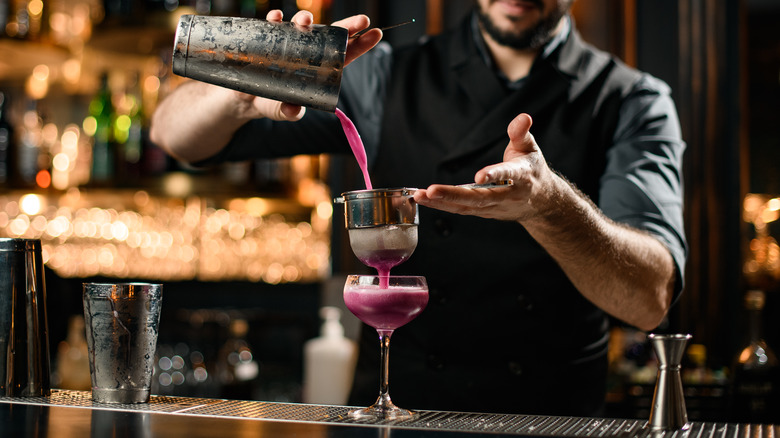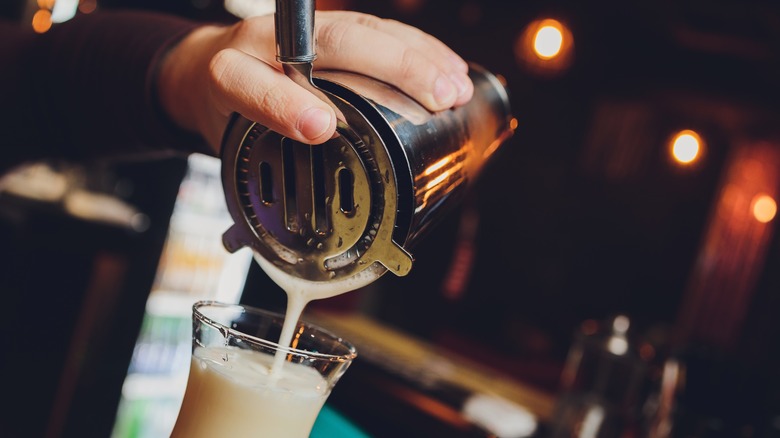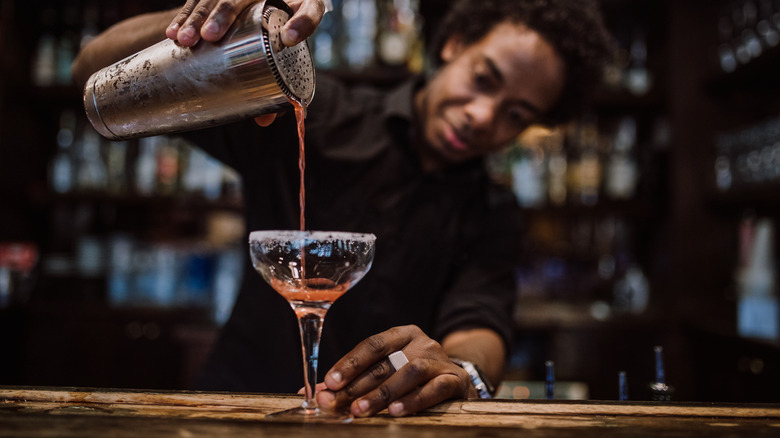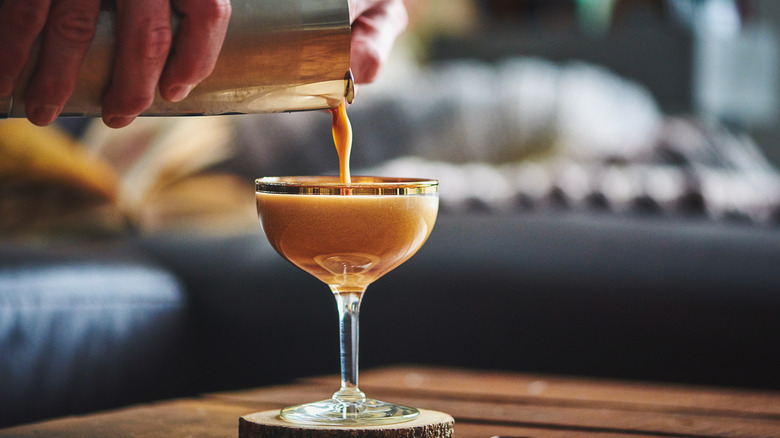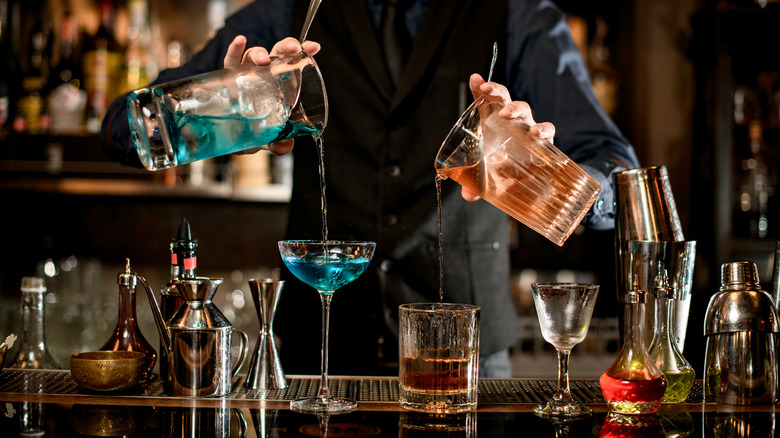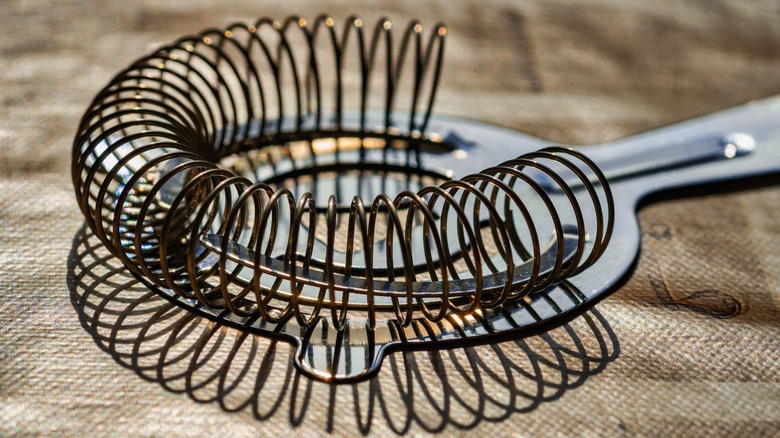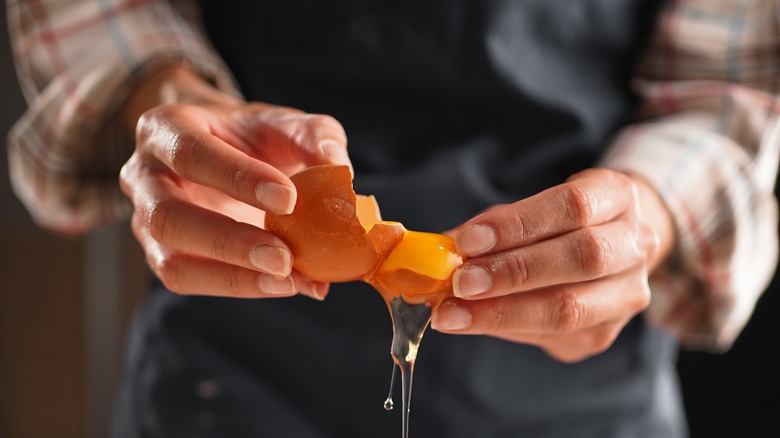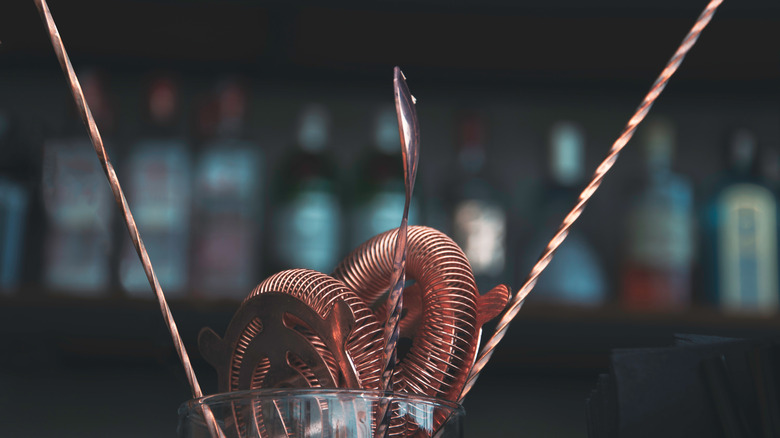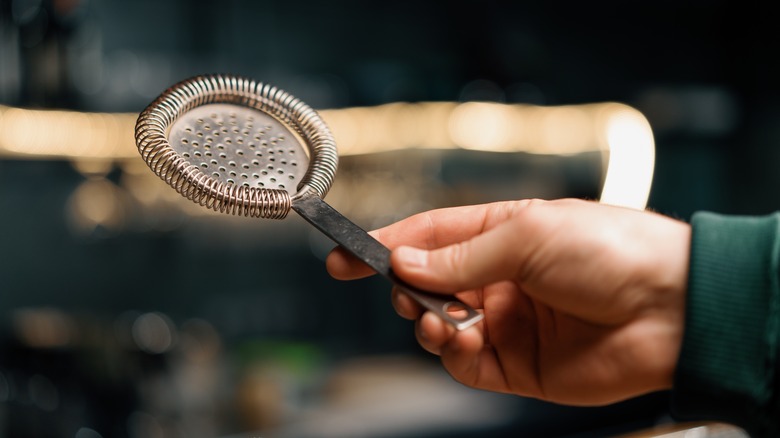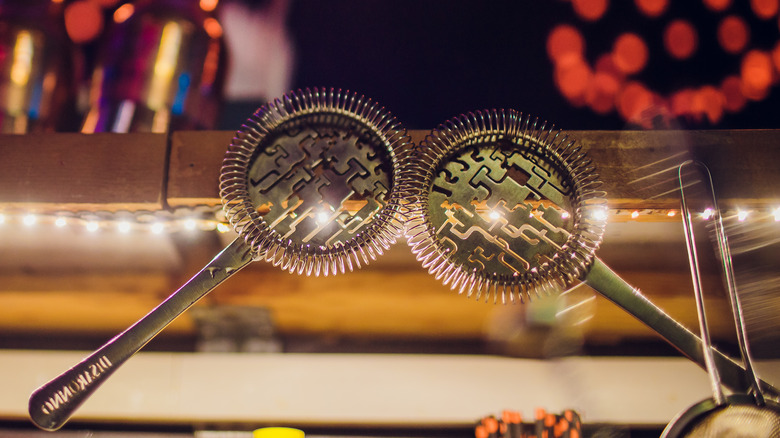10 Tips For Using A Hawthorne Strainer, According To A Bartender
Most cocktails are shaken or stirred with ice before being poured into a glass. If a drink is served straight up without ice, you'll need to use a strainer when pouring the liquid. Yet even if a drink is served on the rocks, it should still be separated from the ice used to chill and dilute it and poured over fresh ice. One of the first devices tailor-made for this purpose was named after the classic mint julep cocktail – and, in many ways, the Hawthorne strainer is merely a more effective evolution of the julep strainer.
The Hawthorne strainer is an essential item in any mixologist's toolkit. A perforated metal disk that sits atop the shaker or mixing glass (with a handle that allows the bartender to hold it in place), it's rimmed with a spring that provides control over how much liquid is poured. It's a remarkably simple piece of equipment, but it takes some specialized knowledge to use correctly. After all, while nothing beats having the right tool for the job, a worker is only as good as their tools if they know how to effectively use them.
After 16 years as a professional bartender — where I've worked at beach shacks shaking margaritas in Mason jars and managed high-end cocktail bars with incredibly fancy equipment — I'm well-acquainted with the ins and outs of this vital cocktail tool. Here are 10 tips to keep in mind when using a Hawthorne strainer.
Know which cocktails need double straining
As a must-have bartending tool, it's important to know how and when to use a Hawthorne strainer – and when it's not enough on its own. After all, though the perforations can filter out large pieces of ice, they won't hold back smaller debris. Consequently, a Hawthorne strainer is perfect when you're only straining liquid and ice cubes in stirred drinks, like a martini or old fashioned. Shaken drinks, however, are another story, and may not be the ideal place to use this strainer given the risk of becoming overdiluted or impacting the texture.
Shards of ice will chip off the cubes as they rattle around inside the shaker and may slip through the Hawthorne strainer. These pieces will then continue to melt in the drink, potentially over-diluting the liquid. This can also impact the smooth mouthfeel and make a drink appear cloudy rather than transparent. Of course, if you're pouring a shaken cocktail over ice, the ice shards aren't as important, so a Hawthorne strainer is likely enough.
The exception is if you've added solid ingredients, like mint, that need to be completely filtered out. You'll need to double-strain the cocktail through a second fine strainer in these instances to completely filter out any tiny particles. Double straining means pouring the liquid through both strainers in sequence by holding the Hawthorne strainer above the fine strainer, then filtering the liquid through both into the glass.
Control the pour speed with a Hawthorne trainer
The Hawthorne strainer is unique because it allows finer control over the speed and quantity of liquid that comes out thanks to the spring. The spring creates a barrier between the edge of your vessel and the disk of the strainer, and the tab on top lets you adjust the size of this gap with your finger. In the cocktail world, we call this space the gate. By pushing the tab, you can close the gate (so to speak) by making it narrower.
The most basic function of this technique is that you can adjust the speed at which the liquid comes out. This is useful if you're pouring multiple drinks from one shaker, want to avoid overpouring, or you're working with ingredients that may get too frothy when poured quickly. When the gate is open, most of the liquid is being filtered through the spring itself, which can still allow smaller chunks of ice or solid ingredients through. The more you close the gate, the tighter the spring becomes, and the more it will filter out.
If you close the gate completely, the liquid is then forced through the even smaller holes of the strainer's disk. Keep in mind that even a fully closed gate will allow some shards of ice and smaller bits of solid ingredients through (though we still have the option to double-strain if necessary).
Hold or adjust the cocktail glass if needed
When you watch an experienced bartender make and pour cocktails, they usually do it with the glass sitting on the bar. However, there's nothing wrong with adjusting or holding the glass if you need to when pouring — especially if you're still practicing with a Hawthorne strainer.
One of the most common instances where you might need to hold the cocktail glass is if you're making a frothy cocktail like a whiskey sour. If you pour too quickly or from too great a height, more air is introduced into the liquid; this can froth up and lead to spillage, or having to wait for the liquid to settle before you can top up the drink. Consider pouring it like a beer or soda, then, by tilting the glass at a 45-degree angle and bringing the shaker closer.
Frankly, since controlling the flow with a Hawthorne strainer can take some getting used to, I'd recommend holding any glassware that's delicate or top-heavy. If you pour too quickly into such a glass, there's a chance it may topple over and break — a lesson I've learned the hard way. If you do need to hold a glass steady, remember the golden rule of bartending, and avoid putting your hands on the top ⅔ of the glass where someone will put their mouth.
Don't be afraid to strain with both hands
Another useful aspect of the Hawthorne strainer is that it's designed for use with one hand. After all, the spring changes shape to allow the strainer to sit flush on most shakers and mixing glasses, while the disk has protruding tabs that keep your vessel in place when you invert it to pour. Of course, while the ability to use a Hawthorne strainer one-handed is ideal — because it frees you up to multi-task and work more efficiently — don't be afraid to use two hands if you're still learning (or simply more comfortable with both hands).
Even experienced bartenders need to occasionally resort to using two hands with a Hawthorne strainer, particularly with larger mixing glasses. Using one hand relies on you being able to grip the whole vessel in one hand, after all. This isn't an issue for someone with gorilla hands (like myself), but if you're struggling to get a grip, feel free to use both.
To do this, hold the strainer in place with your middle three fingers, and use your thumb and pinky to grip the top of the shaker or mixing glass. You can then use your other hand to get a firmer hold on the vessel. I suggest using your dominant hand to hold the strainer, as this will give you more precision when you tip the vessel to pour the liquid, as well as more control over the gate.
Practice using a Hawthorne strainer to improve technique
It's no secret that practicing something will make you better at it. Still, I feel it's worth highlighting this when it comes to bartending. While you'll eventually master cocktail-making techniques through repetition if you work in a busy bar (along with exposure and advice from hopefully helpful colleagues), if it's more of a hobby? You'll need to work a bit harder to nail the more dexterous feats of bartending — including the proper and effective usage of a Hawthorne strainer.
Now, obviously, making actual cocktails offers the best experience because you'll be honing a range of techniques (like recipe memorization and accurate measuring). But you can still train without using real ingredients — and if you want to get a lot of reps in, this method is much kinder to your liver. In fact, if you're determined to practice using a Hawthorne strainer, you can easily do so with tap water and ice.
The first skill to lock down is using the strainer with one hand. When you're happy with your progress, try switching up the size and type of the vessel you're straining from. You can also experiment with different varieties of ice to learn what will and won't escape through the gate. With these techniques mastered, you can even move on to multi-tasking — like straining from two vessels at once, using your off-hand to double-strain, or straining one drink while preparing another.
Rinse your Hawthorne strainer between each drink
One of the most critical skills a professional bartender can have is the ability to clean and tidy their tools and station while they work. Now, full disclosure here: Out of every cocktail-making skill and technique, this is the one I found the trickiest to adhere to. It's one thing when you're making a single drink for yourself or a few friends ... but it's a different story when you're serving a vast range of cocktails to a seemingly endless sea of customers. Regardless of the venue, the main reason it's so important to clean tools as you go is to prevent cross-contamination of ingredients between different drinks.
Most of the time, it's enough to rinse your equipment under running water. Use cold water where possible, as this will prevent your tools from heating up (especially metal ones). You don't want to warm cocktails this way given it may melt the ice more quickly and over-dilute the drink.
Another reason why it's a good idea to rinse a Hawthorne strainer between uses is to clean the spring. While it's an excellent filter, it's very easy for debris to get stuck in the spring, and you'll find the strainer becomes less and less effective after every use if uncleaned. Fortunately, the spring of a Hawthorne strainer is simple to remove, so you can rinse it separately from the disk and slide it back into place after.
Hawthorne strainers can be used to strain more than just cocktails
One of the perks of owning bar tools is that many of them have multiple uses. Some of these additional features are still handy for making cocktails. For example, bar spoons often have a flat disk on the end for muddling ingredients. Other tools can even be used in food preparation, like how a fine strainer can be used for dusting sugar or a cocktail shaker for making salad dressing. Unsurprisingly, the Hawthorne strainer definitely falls into the category of multi-purpose bar tools.
For starters, you can use it to strain things like homemade broth into a shaker or mason jar. You can also use it to separate egg whites from the yolk. This is handy if you need to separate the egg for a baking recipe (or add egg whites to a sour cocktail). But the thing I've found the Hawthorne strainer most useful for (outside of its intended purpose, of course) is making the topping for whipped cream cocktails.
Now, while there are plenty of ways to make whipped cream, they usually require some sort of appliance if you're not whisking by hand. If I'm behind the bar, though, I'll simply add heavy cream to a cocktail shaker with the spring from a Hawthorne strainer (and an ice cube to keep the cream cold). It takes some elbow grease, but a few minutes of vigorous shaking results in perfect whipped cream.
Thoroughly clean your Hawthorne strainer when you've finished with it
Even if you're rinsing your Hawthorne strainer between cocktails, it needs a thorough clean when you're done with it. A rinse isn't enough to remove unseen contaminants that can grow over time, after all. Thankfully, most Hawthorne strainers are dishwasher-safe (look for some sort of label or documentation to confirm it). If you work in a bar, though, you may want to avoid cleaning a Hawthorne strainer in a glasswasher.
It may sound like nit-picking, but you try to avoid putting this cocktail tool in a glasswasher — especially if the strainer has been in contact with cream or food ingredients. These can deposit fatty or oily residue onto the glassware which remains after the wash cycle, degrading its quality and appearance. It's also not a great idea to put light metal objects in a machine that fires high-pressure water jets at glass. There's been more than one occasion that I've opened the door to shattered cocktail glasses and had to dig around in hot soapy water to locate the Hawthorne's spring.
Consequently, I prefer to wash my Hawthorne strainer by hand when I'm done making cocktails for the night. Simply remove the spring, clean both parts of the tool in a sink of warm water and dish soap, then rinse. Dry the strainer thoroughly when you're done and store it somewhere dry to avoid rust or mold.
Replace a Hawthorne strainer sooner rather than later
Most bar tools are built to last, especially if you use them as intended and keep them clean. However, they're not infallible, and it's always better to replace equipment, like a Hawthorne strainer, before it has the chance to give up the ghost mid-use.
In the case of Hawthorne strainers, the point of failure is almost always the spring. Even if you're careful with it, regularly removing and replacing the spring will start to bend it out of shape. The spring's material will also fatigue over time with use, making it less pliable. This can make it less effective at straining and give you less control over the gate. It also makes the strainer less reliable when it comes to securing it inside the mouth of your shaker or mixing glass. This issue can be a particularly messy one if the strainer slips while you're pouring a cocktail (you can trust me on that one).
You can visually assess the condition of your Hawthorne strainer before you use it, and you should start to notice when it's not performing as well as it should. Although it's possible to buy a replacement spring, I've found that's not really cost effective unless you've got a fancy strainer that you're personally attached to. If you have a faulty strainer but the spring works fine, keep hold of it and you can use it as a replacement in the future.
You don't need to break the bank on a Hawthorne strainer
You can often find essential bar tools at a reasonable price. In fact, I'd say there are diminishing returns on more expensive products, with the priciest equipment rarely offering much more than cheaper versions. With that in mind, you realistically only need to spend between $10 and $20 for a perfectly serviceable (and durable) stainless steel Hawthorne strainer.
The higher end of that price range typically nets you some cosmetic variation, like choice of color, though this generally just consists of colored or plated stainless steel. Brass strainers tend to be even more expensive, though they need to be cleaned regularly with vinegar or lemon juice to prevent them from tarnishing. Premium-priced strainers may also be weightier or have extra protrusions for securing them in place, which can be preferable for some bartenders.
Ultimately, the most important feature of a good Hawthorne strainer is a tight spring. This isn't to say that you should never splurge on a Hawthorne strainer if you want to — just that the functions aren't likely to improve. There are plenty of beautifully designed strainers which high-end cocktail bars may want to use to boost the aesthetic. But if you're simply looking to equip a home bar on a budget, there's no need to throw down excessive amounts of cash for a functional cocktail tool.

